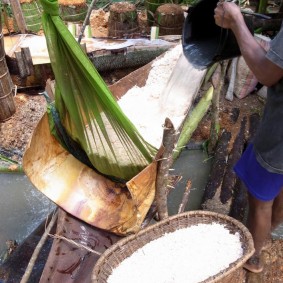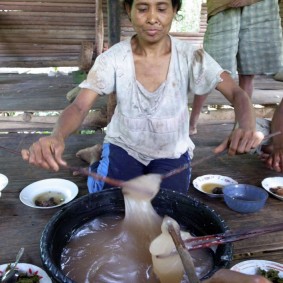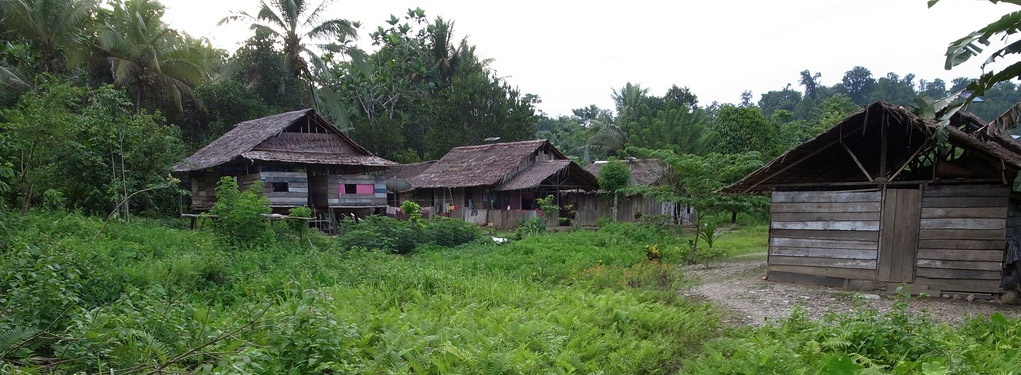When the time came to depart Base Camp A and head inland to the central mountains we were given a choice of two trails. The stories that came back from staff and venturers who had done the ‘yo-yo’ trail that went via Base Camp B, with its notorious series of steep ascents and descents, convinced our group that the longer but less strenuous trail via the villages of Wasa and Roho (pictured above) would be a more enjoyable experience. So we set off with three full walking days ahead of us.
Our journey took us through forest that became increasingly taller and more dense. At the end of each day we soaked our weary bodies in the cool, refreshing shallows of the rivers that ran past the villages where we would spend the night. I remember the water being quite cold but it felt so good to wash away the grime of the day. The hospitality of the nuaulu people was also fantastic. It was a joy and a privilege to be invited into their homes where we could enjoy a comfortable night’s sleep.
Tree of life
During our walk we met a small group of nuaulu in the forest extracting starch from a sago palm. This is a major staple food for the lowland peoples of New Guinea and the Moluccas, where it is called saksak, rabia or sagu. The inner core of the sago tree is packed with starch but it’s too woody to eat raw so it needs to be extracted and then cooked.

The trunk of the sago palm must be six metres high before the tree is felled. Once the tree has been felled and the branches cut, the outer layer of bark is taken off. Sago is extracted by splitting the stem lengthwise and removing the central pith, which is crushed and kneaded then washed to leach out natural toxins and strained to extract the starch from the fibrous residue. The milky liquid containing the starch is left to sit in the basin made from the sago trunk. When the starch has settled, the water is released and the sago is collected and packed to be taken home.

Four trees will feed a family for a year. It is traditionally cooked and eaten in various forms, such as rolled into balls, baked to create a bread, pancake, or biscuit or mixed with boiling water to form a paste. Sago is often produced commercially in the form of ‘pearls’. Sago pearls can be boiled with water or milk and sugar to make a sweet sago pudding. Sago pearls are similar in appearance to tapioca pearls, and the two may be used interchangeably in some dishes.
In addition to its use as a food source, the leaves of the sago palm are used for construction materials and for thatching roofs, and the fibre can be made into rope. Here is a great little video that is part of the Ray Mears World of Survival (BBC) series, which shows how the nuaulu people use every part of the sago palm and extract the starch.
Wet and wild
As the track climbed higher into the central mountain range, it became cooler and wetter and we trudged through long, heavy downpours of rain. I was pleased I had packed my personal belongings in sturdy plastic bags inside my backpack because this kept everything quite dry. We took regular rest breaks and whilst it was great to drop the pack and sit and rest our legs, we needed to be watchful of the leeches that became aware we were there – a tempting meal that they hurried towards.
These rainforest leeches are small, live in the leaf litter and move across the rainforest floor like inchworms looping their way towards their next meal. At first I was relieved that the leeches were so small – they didn’t seem so threatening but then I learnt that this poses a problem. Being small makes them more difficult to detect and they can get into spaces like nostrils and ears and places where you really don’t want a leech to be. So I was vigilant when we stopped to rest and by wearing long pants tucked into my jungle boots the leeches were never really a problem.
The three days went fast and soon we had arrived at the delightful enclave village of Kanikeh.
Go to ‘Leaving the coast’ Photo Gallery
Roho village and sago photos by Kai Bansner

